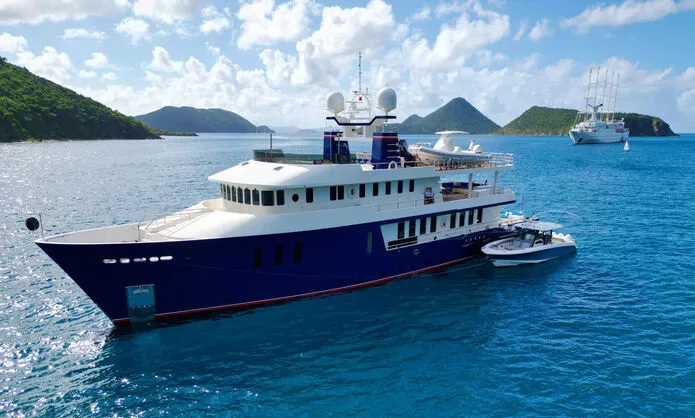Motor yachts are luxurious vessels designed for pleasure cruising, offering a blend of comfort, performance, and style. Powered by internal combustion engines, these yachts provide the convenience of traveling at various speeds without reliance on wind or sails. Over the years, motor yachts have evolved in size, design, and functionality, catering to diverse preferences and needs.
What is a Motor Yacht?
A motor yacht is a type of yacht propelled by one or more engines, typically internal combustion engines running on diesel or gasoline. Unlike sailing yachts that depend on wind power, motor yachts offer greater control over speed and navigation, making them popular choices for leisure boating.
Key Characteristics:
- Size: Motor yachts vary significantly in size, ranging from compact models around 27 feet to expansive superyachts exceeding 100 feet in length.
- Design: They are designed for comfort and luxury, often featuring multiple decks, spacious cabins, and various amenities.
- Amenities: Common features include fully equipped kitchens (galleys), multiple bathrooms (heads), entertainment systems, and outdoor spaces for relaxation and socializing.
Types of Motor Yachts
Motor yachts come in various styles and sizes, each tailored to specific preferences and activities. Here are some common types:
1. Express Cruiser
- Size: Typically between 25 to 50 feet.
- Design: Sleek, modern lines with an open cockpit or salon at deck level.
- Amenities: Basic living amenities, including a small kitchen, sleeping quarters, and a bathroom.
Ideal for: Day trips or weekend getaways, offering speed and style for those new to yachting.
2. Flybridge Yacht
- Size: Usually between 40 to 100 feet.
- Design: Features an upper deck or flybridge with additional helm controls and seating.
- Amenities: Spacious living areas, multiple cabins, larger kitchens, and luxurious fittings.
Ideal for: Extended cruising with family or friends, providing a blend of outdoor and indoor spaces.
3. Trawler
- Size: Commonly found between 35 to 70 feet.
- Design: Built for long-range cruising at lower speeds, emphasizing fuel efficiency.
- Amenities: Comfortable living spaces designed for long stays, equipped with home-like amenities.
Ideal for: Long voyages and those who prefer a slower, more relaxed cruising experience.
4. Sport Fishing Yacht
- Size: Typically from 30 to 70 feet.
- Design: Robust build with a deep-V hull for stability in rough waters.
- Amenities: Features tailored for fishing, such as large cockpits, fish lockers, bait stations, and advanced navigational electronics.
Ideal for: Anglers seeking a combination of comfort and functionality.
5. Mega Yacht
- Size: Over 100 feet, often reaching up to 200 feet.
- Design: Custom-built with multiple decks and expansive indoor and outdoor spaces.
- Amenities: High-end luxury fittings, including gyms, cinemas, large guest suites, and sometimes even pools or helipads.
Ideal for: Ultimate luxury experiences, accommodating large parties, and extended, lavish cruising.
Motor Yacht Construction and Materials
The construction of motor yachts involves various materials, each chosen for specific properties:
- Fiberglass: Commonly used due to its durability, flexibility, and ease of maintenance. Introduced in the 1960s, fiberglass revolutionized yacht building by offering a lightweight and strong alternative to traditional materials.
- Steel: Preferred for larger yachts requiring robust structural integrity. Steel offers strength and durability, making it suitable for extended voyages and heavy-duty use.
- Aluminum: Valued for its lightweight properties and resistance to corrosion, aluminum is often used in the construction of superyachts, allowing for faster speeds and fuel efficiency.
Propulsion Systems
Motor yachts utilize various propulsion systems, with the choice depending on the yacht’s size, design, and intended use:
- Inboard Engines: Installed within the hull, inboard engines provide efficient power and are commonly found in larger yachts.
- Outboard Engines: Mounted externally at the stern, outboard engines are typically used in smaller yachts, offering simplicity and ease of maintenance.
- Stern Drives: Combining features of inboard and outboard systems, stern drives offer improved performance and handling.
Maintenance and Operation
Operating and maintaining a motor yacht requires knowledge and attention to several factors:
- Regular Inspections: Routine checks of the hull, engines, and onboard systems are essential to ensure safety and longevity.
- Crew Training: Understanding the basics of navigation, safety protocols, and emergency procedures is crucial for all aboard.
- Compliance with Regulations: Adhering to maritime laws and regulations, including safety equipment requirements and environmental standards, is mandatory.
Conclusion
Motor yachts represent a harmonious blend of engineering excellence and luxurious living. From their historical inception to the diverse range of types available today, they continue to captivate enthusiasts worldwide. Whether for day trips, long voyages, fishing expeditions, or extravagant cruises, there’s a motor yacht designed to meet every need and preference.

